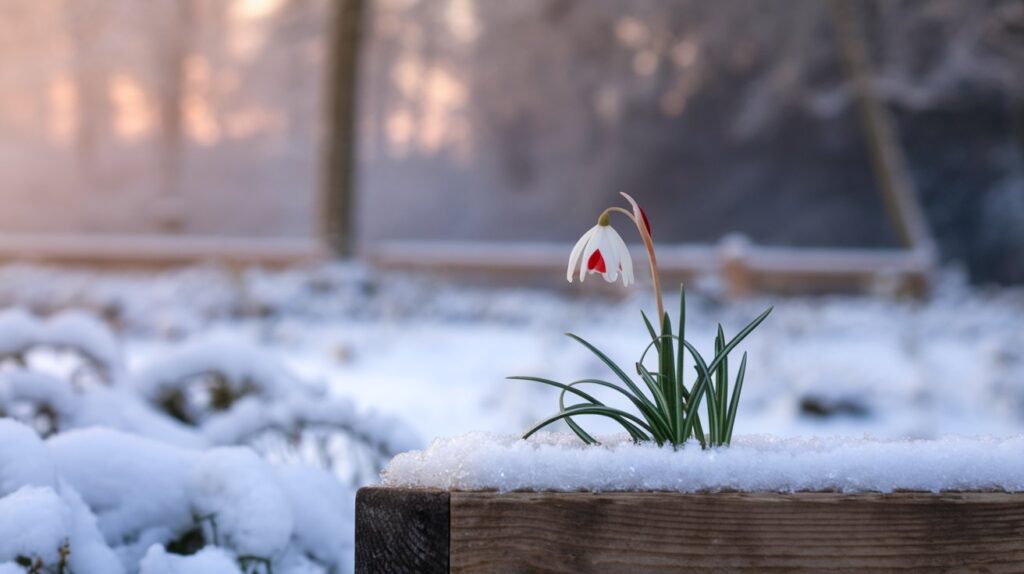Many gardeners assume that winter brings an end to colorful blooms, but several flowers are capable of thriving even when temperatures drop. With the right preparation and proper care, winter gardens can provide a steady source of color and interest during the colder months.
From selecting the right flowers to choosing helpful garden tools like an expandable garden hose, this article offers tips on which flowers tolerate frost and how to support them.
How Do Cold-Tolerant Plants Survive?
Winter-blooming flowers rely on distinct biological characteristics that allow them to withstand lower temperatures. These plants often develop strong root systems that anchor them firmly and help store the nutrients needed for growth when sunlight is limited.
Their leaves and stems typically contain natural compounds that resist freezing, preventing damage during frosty nights. Some cold-tolerant species emerge early in the season because they are adapted to shorter days and cooler soil.
Temperature consistency plays an important role in winter survival. Plants that thrive in these conditions do best when the soil remains well-drained and not overly saturated. Excess moisture can cause roots to freeze or rot, especially when water cycles between freezing and thawing.
Understanding the science behind winter resilience helps gardeners choose species that can reliably produce blooms despite the chill.
Which Flowers Can Tolerate Winter Conditions?
Several flowers are known for their ability to bloom during the winter season. These plants are valued for providing color when most of the garden is dormant. Some produce compact, sturdy blooms that resist frost, while others grow low to the ground where they can shelter themselves from harsh winds.
These include perennials such as hardy cyclamen, witch hazel, and hellebores, as well as annuals like winter-hardy pansies and violas.
Many winter-friendly flowers bloom in subtle shades, providing a gentle contrast against the winter landscape. Others showcase bright colors that stand out clearly against dormant surroundings.
Cold-tolerant species typically include flowers that have evolved in regions with distinct seasonal shifts. These plants begin forming buds earlier than traditional spring flowers and can maintain their structure even when temperatures fluctuate.
By selecting varieties known for their winter performance, gardens can remain active and visually appealing even during the shortest days of the year.
Preparing Soil and Beds for Cold Weather
Proper soil preparation plays a crucial role in helping winter-blooming flowers flourish. Soil structure affects root health, moisture retention, and overall plant stability. Loose, well-aerated soil allows roots to expand and access nutrients more easily during colder months. Adding organic matter supports drainage and improves soil texture, which is essential for preventing waterlogged conditions that can harm winter flowers.
A layer of natural mulch helps regulate soil temperature, protecting roots from rapid changes between warm and cold periods. Mulch also retains moisture, allowing plants to maintain the hydration they need even when rainfall becomes irregular.
Preparing garden beds before temperatures drop helps winter flowers have a strong foundation for growth. Healthy soil helps plants withstand seasonal challenges.
Selecting the Right Location for Winter-Blooming Flowers
Placement plays an important role in the success of winter flowers. Selecting areas that receive consistent sunlight helps support steady growth, especially during months with shorter daylight hours. Locations near south-facing walls or structures can provide slightly warmer conditions that help protect delicate buds.
Soil in these areas often warms more quickly, which allows roots to function efficiently even in colder weather. Adequate airflow, while avoiding exposure to strong winds, creates a balanced environment that allows winter flowers to thrive. Proper placement gives plants the stability they need to maintain healthy blooms throughout the season.
Caring for Winter Flowers Throughout the Season
Caring for winter flowers requires steady attention to moisture, light, and protection. Consistent watering remains important even when temperatures are lower. The soil should remain slightly damp but not overly saturated. Gardeners need to monitor moisture levels closely because colder air and shorter days can reduce natural evaporation.
Light exposure also plays a vital role in winter blooming. Many cold-tolerant flowers rely on direct sunlight to maintain strong growth, even during shorter days. Making sure plants receive adequate light helps them develop blooms that remain strong throughout the season.
Protection from harsh winds and heavy frost can improve the longevity of winter flowers. Placing plants near structures, walls, or natural windbreaks provides beneficial shelter. During extreme cold spells, temporary coverings can help shield blooms and protect them from damage.
Winter Doesn’t Have to Mean an Empty Garden
Winter does not have to signal an end to floral growth. Many flowers are well adapted to cooler temperatures and can continue blooming when the rest of the garden rests. With proper soil preparation, routine care, and an understanding of which species are tolerant of cold temperatures, winter gardens can thrive.
Cold-tolerant flowers bring color and life to outdoor spaces when it is least expected, offering a rewarding experience for gardeners who want beauty throughout the year.

